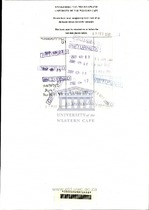| dc.description.abstract | The infants of smoking mothers (compared to non-smoking mothers) have been shown to have a lower birth mass, a lower brain mass, an increased perinatal mortality rate as well as a predisposition to respiratory abnormalities in later life. Evidence suggests that one of the reasons for the latter is abnormal lung structure due to changes in the connective tissue skeleton. This study evaluated the in vivo effects of maternal nicotine exposure (lmg/kg/day subcutaneously - designated the experimental group), which is equivalent to smoking 32 cigarettes per day, on the connective tissue status of the neonatal (7, 14 and 21 day old) wistar rat lung. The control group received sterile saline as a placebo. The specific aspects investigated were: (1) the morphological changes in lung structure and connective tissue (collagen, elastic tissue and reticulin) distribution by means of light microscopy. (2) the quantities of collagen and Emphysema-like morphological changes are present at all ages. The histochemical appearance of collagen is not affected while reticular fibres appear to be abnormal in structure. On day 7 there appears to be no elastic tissue in the nicotine-exposed lung compared to the control lung. This difference is notelastic tissue in the lung. (3) the ultrastructure of the lung connective tissue skeleton by means of scanning electron microscopy. noticeable on days 14 and 21.
Biochemical quantitation indicated that, for the three age groups studied, there was no significant difference in collagen content between experimental and control animals. Elastic tissue was significantly higher in 7 day old experimental lungs than in the control group, contradictory to the results of the histochemical studies. This difference was not significant for 14 and 21 day old lungs Ultrastructural studies of the lung connective tissue skeletons hoed abnormal fibres in the experimental group. Changes included fibre breaks, a beaded appearance of certain fibres and a deficiency in normal fibre arrangement due to the direct or indirect effects of nicotine The effects of nicotine on neonatal rat lung after maternal nicotine exposure is described. The direct mechanisms for these events are still not known but speculation as to this are presented here. Further studies which could explain these mechanisms are also suggested. | en_US |

